Totem pole

Totem poles are monumental sculptures consisting of poles, posts or pillars, carved with symbols or figures. They are usually made from large trees, mostly western red cedar, by indigenous peoples of the Pacific Northwest coast of North America (northwestern United States and Canada's western province, British Columbia). The word totem derives from the Algonquian (most likely Ojibwe) word odoodem [oˈtuːtɛm], "his kinship group". The carvings may symbolize or commemorate cultural beliefs that recount familiar legends, clan lineages, or notable events. The poles may also serve as functional architectural features, welcome signs for village visitors, mortuary vessels for the remains of deceased ancestors, or as a means to publicly ridicule someone. Given the complexity and symbolic meanings of totem pole carvings, their placement and importance lies in the observer's knowledge and connection to the meanings of the figures.
Totem pole carvings were likely preceded by a long history of decorative carving, with stylistic features borrowed from smaller prototypes. Eighteenth-century explorers documented the existence of decorated interior and exterior house posts prior to 1800; however, due to the lack of efficient carving tools, sufficient wealth, and leisure time to devote to the craft, the monumental poles placed in front of native homes along the Pacific Northwest coast probably did not appear in large numbers until the late eighteenth or early nineteenth century. Trade and settlement initially led to the growth of totem pole carving, but governmental policies and practices of acculturation and assimilation sharply reduced totem pole production by the end of nineteenth century. Renewed interest from tourists, collectors, and scholars in the 1880s and 1890s helped document and collect the remaining totem poles, but nearly all totem pole making had ceased by 1901. Twentieth-century revivals of the craft, additional research, and continued support from the public have helped establish new interest in this regional artistic tradition.
History

Totem poles serve as important illustrations of family lineage and the cultural heritage of native peoples who live in the islands and coastal areas of North America's Pacific Northwest, especially British Columbia, Canada, and coastal areas of Washington and southeastern Alaska in the United States. Makers of these poles include the Haida, Tlingit, Tsimshian, Kwakwaka’wakw (Kwakiutl), Nuxalk (Bella Coola), and Nuu-chah-nulth (Nootka).[1][2] Totem poles are typically carved from the highly rot-resistant trunks of Thuja plicata trees (popularly known as giant cedar or western red cedar), which eventually decay in the moist, rainy climate of the coastal Pacific Northwest. Because of the region's climate and the nature of the materials used to make the poles, few examples carved before 1900 remain. Noteworthy examples, some dating as far back as 1880, include those at the Royal British Columbia Museum in Victoria and the Museum of Anthropology at UBC in Vancouver.
Totem poles are the largest, but not the only objects that coastal Pacific Northwest natives use to depict family legends, animals, people, or historical events. The freestanding poles seen by the region's first European explorers were likely preceded by a long history of decorative carving. Stylistic features of these poles were borrowed from smaller prototypes, or from the interior support posts of house beams.[3][4] Although 18th-century accounts of European explorers traveling along the coast indicate that decorated interior and exterior house posts existed prior to 1800, the posts were smaller and fewer in number than in subsequent decades. Prior to the 19th century, the lack of efficient carving tools, along with sufficient wealth and leisure time to devote to the craft, delayed the development of elaborately carved, freestanding poles.[5] Before iron and steel arrived in the area, natives used crude tools made of stone, shells, or beaver teeth for carving. The process was slow and laborious; axes were unknown. By the late eighteenth century, the use of metal cutting tools enabled more complex carvings and increased production of totem poles.[3] The tall monumental poles appearing in front of native homes in coastal villages probably did not appear until after the beginning of the nineteenth century.[5]
The scholar Eddie Malin has proposed that totem poles progressed from house posts, funerary containers, and memorial markers into symbols of clan and family wealth and prestige. He argues that the Haida people of the islands of Haida Gwaii originated carving of the poles, and that the practice spread outward to the Tsimshian and Tlingit, and then down the coast to the indigenous people of British Columbia and northern Washington.[6] Malin's theory is supported by the photographic documentation of the Pacific Northwest coast's cultural history and the more sophisticated designs of the Haida poles. Regional stylistic differences among the poles can be attributed to the application of existing regional artistic styles to a new medium. Earlier theories, such as those of mid-twentieth-century anthropologist Marius Barbeau, who considered the poles a post-contact phenomenon enabled by the introduction of metal tools, are refuted by evidence of the Pacific Northwest's long history of native carving traditions and evaluation of early explorers' and navigators' documents created in the 1790s, which predate the use of iron tools. These early accounts describe and illustrate the existence, although an uncommon appearance, of carved poles and timber homes along the coast of the Pacific Northwest.[7][8] By the early nineteenth century, widespread importation of iron and steel tools from Great Britain, the United States, and elsewhere led to easier and more rapid production of carved wooden goods, including poles.[9] Scholars have not determined if iron tools were introduced by traders, or whether Alaska Natives produced iron tools from drift iron recovered from shipwrecks, but the presence of trading vessels and exploration ships simplified the acquisition of iron tools, the use of which most likely would have enhanced totem pole construction.


In the 19th century, American and European trade and settlement initially led to the growth of totem pole carving, but United States and Canadian policies and practices of acculturation and assimilation caused a decline in the development of Alaska Native and First Nations cultures and their crafts, and sharply reduced totem pole production by the end of the century. Between 1830 and 1880, the maritime fur trade, mining, and fisheries gave rise to an accumulation of wealth among the coastal peoples.[10][11] Much of it was spent and distributed in lavish potlatch celebrations, frequently associated with the construction and erection of totem poles.[12] The monumental poles commissioned by wealthy family leaders to represent their social status and the importance of their families and clans.[13] In the 1880s and 1890s, tourists, collectors, scientists and naturalist interested in native culture collected and photographed totem poles and other artifacts, many of which were put on display at expositions such as the 1876 Centennial Exposition in Philadelphia, Pennsylvania, and the 1893 World's Columbia Exposition in Chicago, Illinois.[14]
In the 19th and early 20th centuries, some Christian missionaries discouraged the natives' traditional practices, including creation of totem poles, and urged converts to cease production and destroy existing poles. Nearly all totem pole making had ceased by 1901.[15] Carving of monumental and mortuary poles continued in some native villages as late as 1905; however, as native sites were abandoned, the poles and timber homes were left to decay and vandalism.[16]
Beginning in the late 1930s, a combination of cultural, linguistic, and artistic revivals, along with scholarly interest and the continuing fascination and support of an educated and empathetic public, led to a renewal and extension of this artistic tradition.[14] In 1938 the United States Forest Service began a program to reconstruct and preserve the old poles, salvaging about 200, roughly one-third of those known to be standing at the end of the 19th century.[16] With renewed interest in native arts and traditions in the 1960s and 1970s, freshly carved totem poles were erected up and down the coast, while related artistic production was introduced in many new and traditional media, ranging from tourist trinkets to masterful works in wood, stone, blown and etched glass, and other traditional and non-traditional media.[14]
Today, a number of successful native artists carve totem poles on commission, usually taking the opportunity to educate apprentices in the demanding art of traditional carving and joinery. Modern poles are almost always executed in traditional styles; however, some artists have included modern subject matter or used nontraditional styles. A commission for a modern pole ranges in the tens of thousands of dollars and usually requires from six to twelve months to complete. Because the time spent on carving after an initial design is may take a year to complete, the commission essentially functions as the artist's primary means of income during the period.
Meaning and purpose
Totem poles symbolize characters and events of a myth or relate the experiences of known ancestors or living people.[2] Some of these characters may appear as stylistic representations of objects in nature, while others are more realistically carved. Pole carvings may include animals, like fish, plants, insects, and humans, or they may represent supernatural beings such as the Thunderbird. Some symbolize animals that than can transform themselves into another form, so they appear as combinations of animals or part animal-part human forms. Consistent use of a specific character over time, with some slight variations in carving style, helped develop similarities among these shared symbols that allowed people to recognize one from another. For example, the raven is symbolized by a long, straight beak, while the eagle's beak is curved, and a beaver is depicted with two large front teeth, a piece of wood held in his front paws, and a paddle-shaped tail.[17][18]
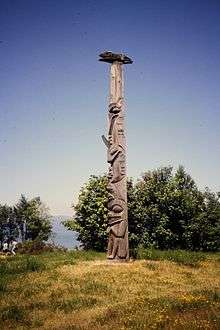
The meanings of the designs on totem poles are as varied as the cultures that make them. Some poles celebrate cultural beliefs that may recount familiar legends, clan lineages, or notable events, while others are mostly artistic. Animals and other characters carved on the pole are typically used as symbols to represent characters or events in a story; however, some may reference the moiety[19] of the pole’s owner, or simply fill up empty space on the pole.[20] The carved figures interlock, one above the other, to create the pole, which may rise to a height of sixty feet or more. Smaller carvings may be positioned in vacant spaces, or they may be tucked inside the ears or hang out of the mouths of the pole’s larger characters.[21][22]
While the intended purpose varies, pole carvings symbolize or commemorate historic persons, represent shamanic powers, or provide objects of public ridicule.
"Some of the figures on the poles constitute symbolic reminders of quarrels, murders, debts, and other unpleasant occurrences about which the Native Americans prefer to remain silent... The most widely known tales, like those of the exploits of Raven and of Kats who married the bear woman, are familiar to almost every native of the area. Carvings which symbolize these tales are sufficiently conventionalized to be readily recognizable even by persons whose lineage did not recount them as their own legendary history."[23]
Totem poles were never objects of worship,[24] but very early European explorers thought they were. However, later explorers such as Jean-François de La Pérouse noted that the poles were never treated reverently. Their purpose seemed only to generate allusions or illustrate stories, and the poles were usually left to rot in place when people abandoned a village. Their association with idol worship was an idea from local 19th-century Christian missionaries, who considered their association with Shamanism as an occult practice.

The vertical order of images is widely believed to be a significant representation of importance, an idea that became so pervasive it entered into common parlance with the phrase "low man on the totem pole". This phrase, indicative of the most common belief of ordering importance, suggests the higher figures on the pole are more important or prestigious. A counterargument frequently heard is that the figures are arranged in reverse hierarchy, with the most important representations on the bottom, at eye level with the viewer to heighten his significance.[25] There are no restrictions on vertical order; many poles have significant figures on the top, others on the bottom, and some in the middle. Other poles have no vertical arrangement, consisting of a lone figure atop an undecorated column.
Given the complexity and symbolic meanings of carvings totem poles, their placement and subsequent importance lies in the observer's knowledge and connection to the meanings of the pole's figures. Asserting that one figure, story, or history has more importance over another because of its placement on a pole may reflect the observer's own cultural perceptions of hierarchy rather than the actual significance of the figures. For example, sometimes a prestigious family crest is placed at the bottom in support of the remainder of the crests or carvings above it. Placement at the bottom of the pole increases a carving's prominence because totem pole logs are thicker towards the base, contributing to the increase in the bottom figure's size, and its position brings the lower figure closer to the people, increasing their interaction with it. Haida doorways, often embedded in the bottoms of house-frontal poles, were kept deliberately small. To enter, guests and members of the household would need to bow in respect to the family crest on the pole. In contrast, the tops of Haida poles often feature a family's moiety crest. Because the Haidas come from one of two moieties and identify themselves as the descendants of an eagle or a raven-associated family, this association and the appearance of an eagle or raven carving at the top if the family's pole could either signify its relevance as the first, or highest, level of family identity and societal structure, or its lesser importance as one of the most common and least exclusive crests.
Types
There are six basic types of totem poles: house frontal poles, interior house posts, mortuary poles, memorial poles, welcome poles, and the ridicule or shame pole.[26]
House frontal poles
This type of pole, usually 20 to 30 feet tall[27] is the most decorative. Its carvings tell the story of the family or clan who own them. These poles are also known as heraldic, crest, or family poles. Poles of this type are placed outside the clan house of the most important village leaders. Often, watchman figures are carved at the top of the pole to protect the pole owner’s family and the village. Another type of house frontal pole is the entrance or doorway pole, which is attached to the center front of the home and includes an oval-shaped opening through the base that serves as the entrance to the clan house.[28]
House posts
These interior poles, typically 8 to 10 feet in height, are usually shorter than exterior poles.[27] The interior posts support the roof beam of a clan house and include a large notch at the top, where the beam can rest.[28] A clan house may have two to four or more house posts, depending on the native group who built it. Carvings on these poles, like those of the house frontal poles, are often used as a storytelling device for children and help tell the story of the owners' family history.[29][30]
Mortuary pole
The rarest type of totem pole is a mortuary structure that incorporates grave boxes with carved supporting poles or includes a recessed back to hold the grave box. It is among the tallest, reaching 50 to 60 feet in height, and most prominent pole.[29] The Haida and Tlingit people erect mortuary poles at the death of important individuals in the community. These poles may have a single figure carved at the top, which may depict the clan's crest, but carvings usually cover its entire length. Ashes or body of the deceased person is placed in the upper portion of the pole.[30]
Memorial pole
This type of pole, which usually stands in front of a clan house, is erected about a year after a person has died. The clan chief’s memorial pole may be raised at the center of the village.[29] The pole's purpose is to honor the deceased person and identify the relative who is taking over as his successor within the clan and the community. Traditionally, the memorial pole has one carved figure at the top, but an additional figure may also be added at the bottom of the pole.[30]
Memorial poles may also commemorate an event. For example, several memorial totem poles were erected by the Tlingits in honor of Abraham Lincoln, one of which was relocated to Saxman, Alaska, in 1938.[31] The Lincoln pole at Saxman commemorates the end of hostilities between two rival Tlingit clans and symbolizes the hope for peace and prosperity following the American occupation of the Alaskan territory.[32] The story begins in 1868, when the United States government built a customs house and fort on Tongass Island and left the U.S, revenue cutter Lincoln to patrol the area. After American soldiers at the fort and aboard the Lincoln provided protection to the Tongass group against its rival, the Kagwantans, the Tongass group commissioned the Lincoln pole to commemorate the event.[33][34]
Welcome pole
Carved by the Kwakwaka'wakw (Kwakiutl) and Nuu-chah-nulth (Nootka) people, these poles include a large carvings of human figures, some as tall as 40 feet.[35] Welcome poles are placed at the edge of a stream or saltwater beach to welcome guests to the community, or possibly to intimidate strangers.[30][36][37]
Shame/ridicule pole
Poles used for public ridicule are usually called shame poles, and were created to embarrass individuals or groups for their unpaid debts or when they did something wrong.[30][38] The poles are often placed in prominent locations and removed after the debt is paid or the wrong is corrected. Shame pole carvings represent the person being shamed.[30][39]

One famous shame pole is the Seward Pole at the Saxman Totem Park in Saxman, Alaska. It was created to shame former U.S. Secretary of State William H. Seward for not reciprocating the courtesy or generosity of his Tlingit hosts following a potlatch given in his honor. The intent of this pole is indicated by the figure's red-painted nose and ears to symbolized Seward's stinginess.[40][41]
Another example of the shame pole is the Three Frogs pole on Chief Shakes Island, at Wrangell, Alaska. This pole was erected by Chief Shakes to shame the Kiks.ádi clan into repaying a debt incurred for the support of three Kiks.ádi women who were allegedly cohabiting with three slave in Shakes's household. When the Kiks.ádi leaders refused to pay support for the women, Shakes commissioned a pole with carvings of three frogs, which represented the crest of the Kiks.ádi clan. It is not known if the debt was ever repaid.[42] The pole stands next to the Chief Shakes Tribal House in Wrangell. The pole's unique crossbar shape has become popularly associated with the town of Wrangell, and continues to be used as part of the Wrangell Sentinel newspaper's masthead.[43]
In 1942, the U.S. Forest Service commissioned a pole to commemorate Alexander Baranof, the Russian governor and Russian American Company manager, as a civilian works project. The pole's original intent was to commemorate a peace treaty between the Russians and Tlingits that the governor helped broker in 1805. George Benson, a Sitka carver and craftsman, created the original design. The completed version originally stood in Totem Square in downtown Sitka, Alaska.[44][45] When Benson and other Sitka carvers were not available to do the work, the U.S. Forest Service had CCC workers carve the pole in Wrangell, Alaska. Because Sitka and Wrangell native groups were rivals, it has been argued that the Wrangell carvers may have altered Benson's original design.[45][46] For unknown reasons, the Wrangell carvers depicted the Baranov figure without clothes.[47] Following a Sitka Tribe of Alaska-sponsored removal ceremony, the pole was lowered due to safety concerns on October 20, 2010, using funds from the Alaska Dept. of Health and Social Services. The Sitka Sentinel reported that while standing, it was "said to be the most photographed totem [pole] in Alaska".[44] The pole was re-erected in Totem Square in 2011.[48]
On March 24, 2007, a shame pole was erected in Cordova, Alaska, that includes the inverted and distorted face of former Exxon CEO Lee Raymond. The pole represents the unpaid debt on $5 million in punitive damages that a federal court in Anchorage, Alaska, determined Exxon owes for its role in causing the Exxon Valdez oil spill in Prince William Sound.[49][50]
Totem poles outside of original context
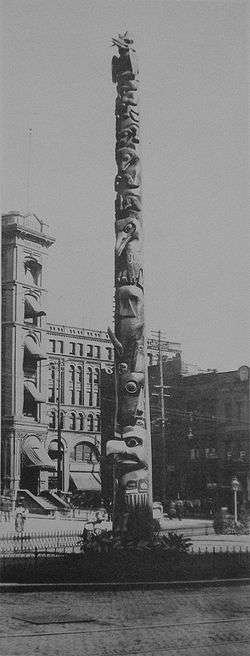
Some poles from the Pacific Northwest have been moved to other locations for display out of their original context.[51]
In 1903 Alaska’s district governor, John Green Brady, collected fifteen Tlingit and Haida totem poles for public displays from villages in southeastern Alaska.[52][53] At the Louisiana Purchase Exposition (the world's fair held in Saint Louis, Missouri, in 1904), fourteen of them were initially installed outside the Alaska pavilion at the fair; the other one, which had broken in transit, was repaired and installed at the fair's Esquimau Village.[54] Thirteen of these poles were returned to Alaska, where they were eventually installed in the Sitka National Historical Park. The other two poles were sold; one pole from the Alaska pavilion went the Milwaukee Public Museum and the pole from the Esquimau Village was sold and then given to industrialist David M. Parry, who installed it on his estate in what became known as the Golden Hill neighborhood of Indianapolis, Indiana.[55] Although the remains of the original pole at Golden Hill no longer exist, a replica was raised on April 13, 1996, on the front lawn of The Eiteljorg Museum of American Indians and Western Art in Indianapolis.[56] Approximately two years later, the replica was moved inside the museum, and in 2005, it was installed in a new atrium after completion of a museum expansion project.[57]
Indian New Deal
The Indian New Deal of the 1930s strongly promoted native arts and crafts, and in the totem pole they discovered an art that was widely appreciated by white society. In Alaska the Indian Division of the Civilian Conservation Corps restored old totem poles, copied those beyond repair, and carved new ones. The Indian Arts and Crafts Board, A federal government agency, facilitated their sale to the general public. The project was lucrative, but anthropologists complaining that it stripped the natives of their traditional culture and stripped away the meaning of the totem poles.[58][59]
Another example occurred in 1938, when the U.S. Forest Service began a totem pole restoration program in Alaska.[60] Poles were removed from their original places as funerary and crest poles to be copied or repaired and then placed in parks based on English and French garden designs to demystify their meaning for tourists.[61]
In England at the side of Virginia Water Lake, in the south of Windsor Great Park, there is a 100-foot (30 m) tall Canadian totem pole that was given to Queen Elizabeth II to commemorate the centenary of British Columbia. In Seattle, Washington, a Tlingit funerary totem pole was raised in Pioneer Square in 1899, after being taken from an Alaskan village.[62] In addition, the totem pole collections in Vancouver's Stanley Park, Victoria's Thunderbird Park, and the Museum of Anthropology at the University of British Columbia were removed from their original locations around British Columbia.
Construction and maintenance
After the tree to be used for the totem pole is selected, it is cut down and moved to the carving site, where the bark and outer layer of wood (sapwood) is removed. Next, the side of the tree to be carved is chosen and the back half of the tree is removed. The center of the log is hollowed out to make it lighter and to keep it from cracking.[63] Early tools used to carve totem poles were made of stone, shell, or bone, but beginning in the late 1700s, the use of iron tools made the carving work faster and easier. In the early days, the basic design for figures may have been painted on the wood to guide the carvers, but today's carvers use paper patterns as outlines for their designs. Carvers use chain saws to make the rough shapes and cuts, while adzes and chisels are used to chop the wood. Carvers use knives and other woodworking tools to add the finer details. When the carving is complete, paint is added to enhance specific details of the figures.[63]
Raising a totem pole is rarely done using modern methods, even for poles installed in modern settings. Most artists use a traditional method followed by a pole-raising ceremony. The traditional method calls for a deep trench to be dug. One end of the pole is placed at the bottom of the trench; the other end is supported at an upward angle by a wooden scaffold. Hundreds of strong men haul the pole upright into its footing, while others steady the pole from side ropes and brace it with cross beams. Once the pole is upright, the trench is filled with rocks and dirt. After the raising is completed, the carver, the carver's assistants, and others invited to attend the event perform a celebratory dance next to the pole. A community potlatch celebration typically follows the pole raising to commemorate the event.[64]
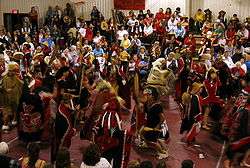
Totem poles are typically not well maintained after their installation and the potlatch celebration. The poles usually last from 60 to 80 years; only a few have stood longer than 75 years, and even fewer have reached 100 years of age.[16] Once the wood rots so badly that the pole begins to lean and pose a threat to passersby, it is either destroyed or pushed over and removed. Older poles typically fall over during the winter storms that batter the coast. The owners of a collapsed pole may commission a new one to replace it.[65]
Views about the lack of maintenance vary among individuals, but it is generally believed that the deterioration of the pole represents the natural process of decay and death that occur with all living things, and attempts to prevent this are seen as somehow denying or ignoring the nature of the world. This belief has not prevented people from occasionally renewing the paint on poles or performing further restorations, mostly because the expense of a new pole is not feasible for the owner. Also, owners of poles who are not familiar with cultural traditions may see upkeep as a necessary investment for property, and ignore the philosophical implications.
Property
Each culture typically has complex rules and customs regarding designs represented on poles. The designs are generally considered the property of a particular clan or family group, and this ownership may not be transferred to the owner of a pole. As such, pictures, paintings, and other copies of the designs are often seen as an infringement of the ownership rights of a certain family or cultural group. Many Native artists, Native organizations and Native governments note that ownership of the artistic designs represented on a pole should be respected as private property to the same extent as the pole. They ask that public display and sale of pictures and other representations of totem pole designs be cleared with the owners of the pole and the cultural group or tribal government associated with the pole's designs.
Because totem poles, in general, are not the exclusive cultural property of a single culture, the designs are not easily protected. The appropriation of coastal Pacific Northwest culture by the art and tourist trinket market has resulted in production of cheap imitations of totem poles executed with little or no knowledge of their complex stylistic conventions. These include imitations made by other First Nations and Native American peoples in Canada and southwestern United States. Proliferation of "totem junk" has diluted public interest and respect for the artistic skill and cultural knowledge required to produce a pole.
In the early 1990s, the Haisla First Nation of the Pacific Northwest began a lengthy struggle to repatriate a sacred totem from Sweden's Museum of Ethnography.[66][67] Their successful efforts were documented in Gil Cardinal's
National Film Board of Canada documentary, Totem: The Return of the G'psgolox Pole.[68]
In October 2015 a Tlingit totem Pole was returned from Hawaii to Alaska[69]
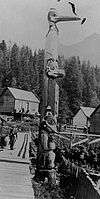 Tlingit totem pole in Ketchikan, Alaska, circa 1901
Tlingit totem pole in Ketchikan, Alaska, circa 1901 Totem poles in front of homes in Alert Bay, British Columbia in the 1900s
Totem poles in front of homes in Alert Bay, British Columbia in the 1900s A totem pole in Totem Park, Victoria, British Columbia
A totem pole in Totem Park, Victoria, British Columbia From Totem Park, Victoria, British Columbia
From Totem Park, Victoria, British Columbia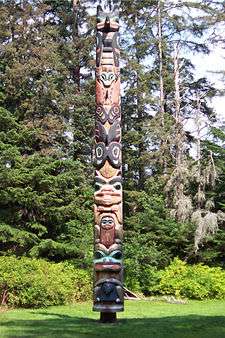 The K'alyaan Totem Pole of the Tlingit Kiks.ádi Clan, erected at Sitka National Historical Park to commemorate the lives lost in the 1804 Battle of Sitka
The K'alyaan Totem Pole of the Tlingit Kiks.ádi Clan, erected at Sitka National Historical Park to commemorate the lives lost in the 1804 Battle of Sitka_2.jpg) From Saxman Totem Park, Ketchikan, Alaska
From Saxman Totem Park, Ketchikan, Alaska_1.jpg) From Saxman Totem Park, Ketchikan, Alaska
From Saxman Totem Park, Ketchikan, Alaska From Brockton Point, Stanley Park, Vancouver, British Columbia
From Brockton Point, Stanley Park, Vancouver, British Columbia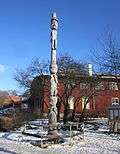 Replica of G'psgolox Pole. A gift from the Haisla First Nation to the Museum of Ethnography in Stockholm, Sweden.
Replica of G'psgolox Pole. A gift from the Haisla First Nation to the Museum of Ethnography in Stockholm, Sweden.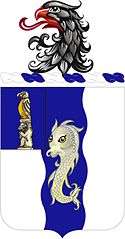 US 50th Infantry Regiment Coat of arms with a totem pole arrangement of a US American eagle and a Russian Bear {signifying transfer of ownership of Alaska from Russia to United States}
US 50th Infantry Regiment Coat of arms with a totem pole arrangement of a US American eagle and a Russian Bear {signifying transfer of ownership of Alaska from Russia to United States}
Totem poles of note
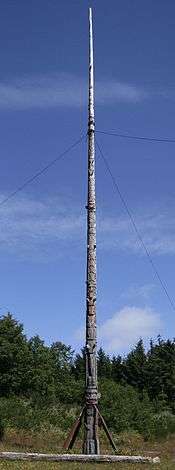
The title of "The World's Tallest Totem Pole" is or has at one time been claimed by several coastal towns of North America's Pacific Northwest.[70] Disputes over which is genuinely the tallest depends on factors such the number of logs used in construction or the affiliation of the carver. Competitions to make the tallest pole remain prevalent, although it is becoming more difficult to procure trees of sufficient height. The tallest poles include:
- Alert Bay, British Columbia—173 feet (53 m), Kwakwaka'wakw. This pole is composed of two or three pieces.[70]
- McKinleyville, California—160 feet (49 m), carved from a single redwood tree by Ernest Pierson and John Nelson.
- Kalama, Washington—149 feet (45 m), carved from a single pole by Lelooska.[70]
- Kake, Alaska—132 feet (40 m), single log carving,[70] Tlingit
- Victoria, British Columbia (Beacon Hill Park)—127.7 feet (38.9 m), raised in 1956,[70] Kwakwaka'wakw, carved by Mungo Martin with Henry Hunt and David Martin.
- Tacoma, Washington (Fireman's Park)—105 feet (32 m), carved by Alaska Natives in 1903.[70]
- Vancouver, British Columbia (Maritime Museum) —100 feet (30 m), Kwakwaka'wakw, carved by Mungo Martin with Henry Hunt and David Martin.
The thickest totem pole ever carved to date is in Duncan, British Columbia. Carved by Richard Hunt in 1988 in the Kwakwaka'wakw style, and measuring over 6 feet (1.8 m) in diameter, it represents Cedar Man transforming into his human form.
Notable collections of totem poles on display include these sites:
- Alaska State Museum, Juneau, Alaska[71]
- Burke Museum of Natural History and Culture, University of Washington, Seattle[72]
- Canadian Museum of History, Hull area of Gatineau, Quebec
- Gwaii Haanas National Park Reserve and Haida Heritage Site, Haida Gwaii, British Columbia
- Haida Heritage Centre, Skidegate, British Columbia
- 'Ksan, near Hazelton, British Columbia
- Museum of Anthropology at UBC, Vancouver, British Columbia
- Nisga'a and Haida Crest Poles of the Royal Ontario Museum, Toronto
- Nisga'a Museum, in Laxgalts'ap, British Columbia
- Royal British Columbia Museum, Victoria, British Columbia
- Saxman Totem Park, Saxman, Alaska[73]
- Sitka National Historical Park, Sitka, Alaska[74]
- Stanley Park (Brockton Point), Vancouver, British Columbia
- Thunderbird Park, Victoria, British Columbia[75]
- Totem Heritage Center, Ketchikan, Alaska[76]
See also
Notes
- ↑ Richard D. Feldman (2012). Home Before the Raven Caws: The Mystery of a Totem Pole (Rev. 2012 ed.). Indianapolis: Indiana Historical Society in association with The Eiteljorg Museum of American Indians and Western Art. p. 4. ISBN 978-0-87195-306-3.
- 1 2 Viola E. Garfield and Linn A. Forrest, (1961). The Wolf and the Raven: Totem Poles of Southeastern Alaska. Seattle: University of Washington Press. p. 1. ISBN 0-295-73998-3.
- 1 2 Garfield and Forrest, p. 1–2.
- ↑ Marius Barbeau (1950). "Totem Poles: According to Crests and Topics". National Museum of Canada Bulletin 119. Ottawa: Dept. of Resources and Development, National Museum of Canada. 1: 9. Retrieved 24 November 2014.
- 1 2 Barbeau, "Totem Poles: According to Crests and Topics", p. 5.
- ↑ Edward Malin (1986). Totem Poles of the Pacific Northwest Coast. Portland, Oregon: Timber Press. ISBN 0-88192-295-1.
- ↑ Joseph H. Wherry (1964). The Totem Pole Indians. New York: W. Funk. p. 23–24.
- ↑ Kramer, Alaska's Totem Poles, p. 18.
- ↑ Kramer, Alaska's Totem Poles, p. 13.
- ↑ Garfield and Forrest, p. 2 and 7.
- ↑ Kramer, Alaska's Totem Poles, p. 21.
- ↑ Garfield and Forrest, p. 7.
- ↑ Feldman, p. 4.
- 1 2 3 Kramer, Alaska's Totem Poles, p. 25.
- ↑ Pat Kramer (2008). Totem Poles. Vancouver, British Columbia: Heritage House. p. 22. ISBN 978-1-89497-444-8.
- 1 2 3 Garfield and Forrest, p. 8.
- ↑ Feldman, p. 6.
- ↑ Garfield and Forrest, p. 3.
- ↑ The Haida, Tlingit, and Tsimshian people separate themselves into two or more major divisions called moieties, which are further divided into small family groups called clans. Traditionally, several families within the same a clan lived together in a large communal house. See Feldman, p. 4.
- ↑ Feldman, pp. 1 and 5.
- ↑ Feldman, p. 1.
- ↑ Garfield and Forrest, p. 4.
- ↑ Ishmael Reed, (ed.) (2003). From Totems to Hip-Hop: A Multicultural Anthology of Poetry across the Americas, 1900-2002. ISBN 1-56025-458-0.
- ↑ Viola E. Garfield (1967). Meet the Totem. Sitka, AK: Sitka Printing Company. p. 10.
- ↑ Oscar Newman (2004). Secret Stories in the Art of the Northwest Indian. New York: Catskill Press. p. 19. ISBN 097201196X.
- ↑ Feldman, p. 12–13.
- 1 2 Newman, p. 16.
- 1 2 Feldman, p. 12.
- 1 2 3 Newman, p. 19.
- 1 2 3 4 5 6 Feldman, p. 13.
- ↑ Garfield and Forrest, p. 55.
- ↑ Garfield and Forrest, p. 54.
- ↑ Barbeau, "Totem Poles: According to Crests and Topics", p. 402–5.
- ↑ Garfield and Forrest, p. 54–55.
- ↑ Newman, p. 21.
- ↑ Wherry, p. 104.
- ↑ Newman, p. 22.
- ↑ Edward Keithahn (1963). Monuments in Cedar. Seattle, Washington: Superior Publishing Co. p. 56.
- ↑ Sheldon Jackson Museum, Sitka, AK. Accessed 23 August 2011
- ↑ Garfield and Forrest, p. 55–56.
- ↑ Kramer, Alaska’s Totem Poles, p. 10.
- ↑ Barbeau, "Totem Poles: According to Crests and Topics", p. 401.
- ↑ "Wrangell Sentinel". Wrangell Sentinel. 21 November 2014. Retrieved 21 November 2014.
- 1 2 Shannon Haugland (21 September 2010), "Totem Square, Pole to get Safety Upgrades", Sitka Sentinel (subscription required)
- 1 2 Anne Sutton (7 June 2008). "Top man on totem pole could get his clothes back". USA Today. Gannett Co. Retrieved 3 December 2014.
- ↑ ""Going Down" photo caption", Sitka Sentinel, 20 October 2010. (subscription required)
- ↑ Anne Sutton (8 June 2008), "Top man on totem pole could get his clothes back", Anchorage Daily News, retrieved 8 December 2009
- ↑ Ronco, Ed (November 30, 2011). "Controversial Totem Pole Returns to Sitka Square". Alaska Public Media.
- ↑ "Shame Pole Mocking Exxon is Planted in Cordova", Anchorage Daily News, 25 March 2007
- ↑ Peter Rothberg (27 March 2007), "Exxon's Shame", The Nation, retrieved 21 November 2014
- ↑ Feldman, p. 25.
- ↑ Feldman, p. 26.
- ↑ "Carved History". Sitka National Park archived website content. U.S. National Park Service. Retrieved 3 December 2014.
- ↑ Feldman, p. 27.
- ↑ Feldman, p. 25–27.
- ↑ Feldman, p. 43 and 52.
- ↑ Feldman, p. 70.
- ↑ Aldona Jonaitis, "Totem Poles And The Indian New Deal," European Contributions to American Studies (1990) Vol. 18, pp 267-277.
- ↑ Robert Fay Schrader, The Indian Arts & Crafts Board: An Aspect of New Deal Indian Policy (University of New Mexico Press, 1983.)
- ↑ Garfield and Forrest, p. v.
- ↑ Emily Moore (31 March 2012). Decoding Totems in the New Deal (Speech). Wooshteen Kanaxtulaneegí Haa At Wuskóowu / Sharing Our Knowledge, A conference of Tlingit Tribes and Clans: Haa eetí ḵáa yís / For Those Who Come After Us. Sitka, Alaska. Retrieved 31 March 2012.
- ↑ Jen Graves (10 January 2012). "A Totem Pole Made of Christmas Lights: Bringing Superwrongness to Life". The Stranger. Seattle, Washington. Retrieved 12 January 2012.
- 1 2 Feldman, p. 21–22.
- ↑ Feldman, p. 22–23.
- ↑ Feldman, p. 24.
- ↑ "Back in Pole Position", Vancouver Sun, 27 April 2006, retrieved 4 May 2010
- ↑ "G'psgolox Totem returnS To British Columbia" (Press release). The Na Na Kila Institute. 26 April 2006. Retrieved 4 May 2010.
- ↑ "Totem: The Return of the G'psgolox Pole". National Film Board of Canada. 8 April 2013. Retrieved 3 December 2014.
- ↑ Returned Totem Pole
- 1 2 3 4 5 6 Kramer, Alaska's Totem Poles, p. 83.
- ↑ Wherry, p. 136.
- ↑ Kramer, Alaska's Totem Poles, p. 90.
- ↑ Garfield, p. 13.
- ↑ Kramer, Alaska's Totem Poles, p. 92.
- ↑ Wherry, p. 140.
- ↑ Kramer, Alaska's Totem Poles, p. 84–85.
References
- Barbeau, Marius (1950) Totem Poles: According to Crests and Topics. Vol. 1. (Anthropology Series 30, National Museum of Canada Bulletin 119.) Ottawa: National Museum of Canada. (PDFs)
- Barbeau, Marius (1950) Totem Poles: According to Location. Vol. 2. (Anthropology Series 30, National Museum of Canada Bulletin 119.) Ottawa: National Museum of Canada. (PDFs)
- Feldman, Richard D. (2012). Home Before the Raven Caws: The Mystery of a Totem Pole (Rev. 2012 ed.). Indianapolis: Indiana Historical Society in association with The Eiteljorg Museum of American Indians and Western Art. ISBN 978-0-87195-306-3.
- Garfield, Viola E. (1951) Meet the Totem. Sitka, Alaska: Sitka Printing Company.
- Garfield, Viola E., and Forrest, Linn A. (1961) The Wolf and the Raven: Totem Poles of Southeastern Alaska. Revised edition. Seattle: University of Washington Press. ISBN 0-295-73998-3.
- Jonaitis, Aldona. (1990) "Totem Poles And The Indian New Deal," European Contributions to American Studies Vol. 18, pp 267–277.
- Keithahn, Edward L. (1963) Monuments in Cedar. Seattle, Washington: Superior Publishing Co.
- Kramer, Pat (2004). Alaska's Totem Poles. Anchorage: Alaska Northwest Books. ISBN 0882405853.
- Kramer, Pat (2008). Totem Poles. Vancouver, British Columbia: Heritage House. p. 22 and 24. ISBN 978-1-89497-444-8.
- Malin, Edward (1986). Totem Poles of the Pacific Northwest Coast. Portland, Oregon: Timber Press. ISBN 0-88192-295-1.
- Newman, Oscar (2004). Secret Stories in the Art of the Northwest Indian. New York: Catskill Press. ISBN 097201196X.
- Reed, Ishmael (ed.) (2003) From Totems to Hip-Hop: A Multicultural Anthology of Poetry across the Americas, 1900-2002. ISBN 1-56025-458-0.
- Wherry, Joseph H. (1964) The Totem Pole Indians. New York: Thomas Y. Crowell Company.
Further reading
- Averill, Lloyd J., and Daphne K. Morris (1995) Northwest Coast Native and Native-Style Art: A Guidebook for Western Washington. Seattle: University of Washington Press.
- Brindze, Ruth (1951) The Story of the Totem Pole. New York: Vanguard Press.
- Halpin, Marjorie M. (1981) Totem Poles: An Illustrated Guide. Vancouver, BC: UBC Press.
- Hassett, Dawn, and F. W. M. Drew (1982) Totem Poles of Prince Rupert. Prince Rupert, BC: Museum of Northern British Columbia.
- Hoyt-Goldsmith, Diane (1990) Totem Pole. New York: Holiday House.
- Huteson, Pamela Rae. (2002) Legends in Wood, Stories of the Totems. Tigard, Oregon: Greatland Classic Sales. ISBN 1-886462-51-8
- Macnair, Peter L., Alan L. Hoover, and Kevin Neary (1984) The Legacy: Tradition and Innovation in Northwest Coast Indian Art. Vancouver, BC: Douglas & McIntyre.
- Meuli, Jonathan (2001) Shadow House: Interpretations of Northwest Coast Art. Amsterdam: Harwood Academic Publishers.
- Smyly, John, and Carolyn Smyly (1973) Those Born at Koona: The Totem Poles of the Haida Village Skedans, Queen Charlotte Islands. Saanichton, BC: Hancock House.
- Stewart, Hilary (1979) Looking at Indian Art of the Northwest Coast. Vancouver, BC: Douglas & McIntyre.
- Stewart, Hilary (1993). Looking at Totem Poles. Seattle: University of Washington Press. ISBN 0-295-97259-9.
External links
| Look up totem pole in Wiktionary, the free dictionary. |
| Wikimedia Commons has media related to Totem poles. |
- Native online.com
- Royal BC Museum, Thunderbird Park–A Place of Cultural Sharing, online interpretive tour
- Totem: The Return of the Gpsgolox Pole, a feature-length film by Gil Cardinal, National Film Board of Canada
- Article related to conservation of Pacific Northwest totem poles
- Totem Poles: Heraldic Columns of the Northwest Coast Essay by Robin K. Wright - University of Washington Digital Collection
